As a trusted Lattice partner, Jungo WinDriver offers ready-to-use drivers and DMA sample projects for Avant and CPNX FPGAs. These eliminate the need for custom driver development, helping engineers save time. You can either access these samples from the sample folder or generate them using the DriverWizard.
WinDriver Lattice DMA Samples
Ready Made DMA Driver Applications for Avant and CPNX
- Avant-E
- ECP5-5G
- CertusPro-NX
Home » WinDriver Lattice DMA Samples: Ready-Made DMA Driver Applications for Avant and CPNX
Understanding the Lattice DMA Workflow
The WinDriver Lattice DMA samples sequence involves:
- Creating Memory Buffers for Data and Descriptors
- Configuring the Descriptor Buffer
- Writing Descriptor Address to the Device
- Initiating the DMA Transfer
- Data Transfer Execution
- Completion and Interrupt Handling
- Cleanup (DMA Close Routine)
Let’s break down each step in detail.
Lattice DMA Workflow
Step 1: Creating Memory Buffers for Data and Descriptors
Before transferring data, memory must be allocated and locked to ensure stability.
The DMA in CPNX requires two types of buffers:
- Data Buffers – Store actual transfer data.
- Descriptor Buffers – Contain metadata such as transfer length and addresses.
Avant DMA required a third type of buffers for the Status, which is stored on the device in CPNX.
Allocating Buffers for the DMA
Using these functions:
- WDC_DMASGBufLock → locks a pre-allocated user-mode memory buffer for the data buffers and returns the corresponding physical mappings of the locked DMA pages.
- WDC_DMAContigBufLock → Allocates a contiguous buffer for the descriptor, locks it in physical memory, and returns mappings of the allocated buffer to physical address space and to user-mode and kernel virtual address spaces.
Allocating & Locking the Memory for the Data

💡 Tip: Avant FPGAs also require a status buffer.
Step 2: Configuring the Descriptor Buffer
Once memory is allocated, descriptors must be set up to define:
- Source and destination addresses
- Transfer length
- Next descriptor address (for chained transfers)

How to Set Up Descriptors
Using the function:
DmaTransferBuild → prepares a list of instructions for the DMA engine to efficiently move data between the CPU and FPGA without involving the processor directly.

Step 3: Writing Descriptor Address to the Device
After descriptor configuration, the descriptor addresses are written to the FPGA. This enables the device to fetch metadata when needed.
Using the function:
- WriteDescriptorsDataToCPNX → configures the FPGA by writing DMA descriptor addresses and counting into its registers so that it knows where to find the descriptors for the data transfer.
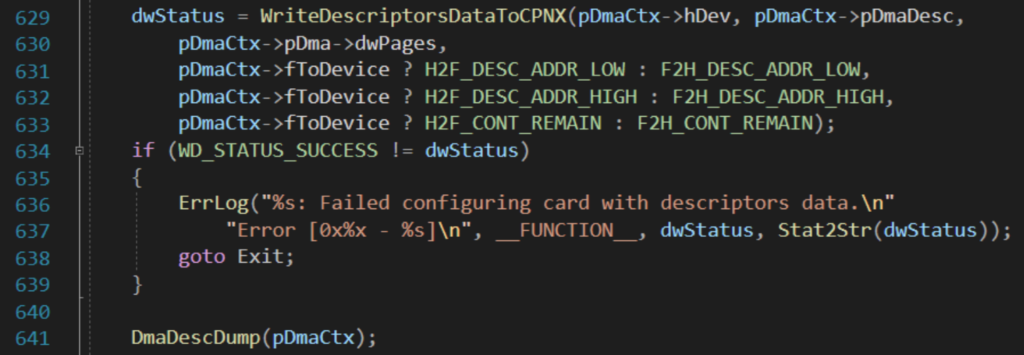
💡 Tip: If you’re using Avant, you must also configure the status buffer.
Step 4: Initiating the DMA Transfer
To begin data transfer, the host writes to a specific offset on the FPGA.
How to Start the Transfer
Use the function:
CPNX_DMA_StartDMA → Initiates DMA transaction.
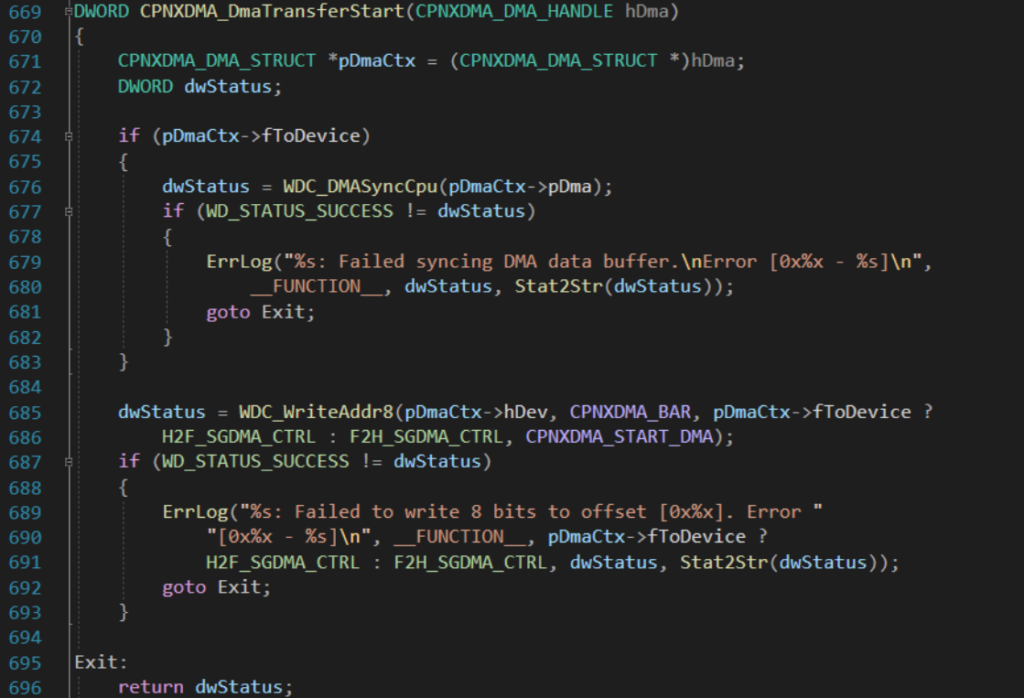
Step 5: Data Transfer Execution
Once started, the FPGA reads the descriptor buffer to fetch the source and destination addresses and moves data accordingly.
How it works:
- First descriptor fetches the first data buffer.
- Upon completion, the next descriptor is processed.
- This continues until the last descriptor is reached.
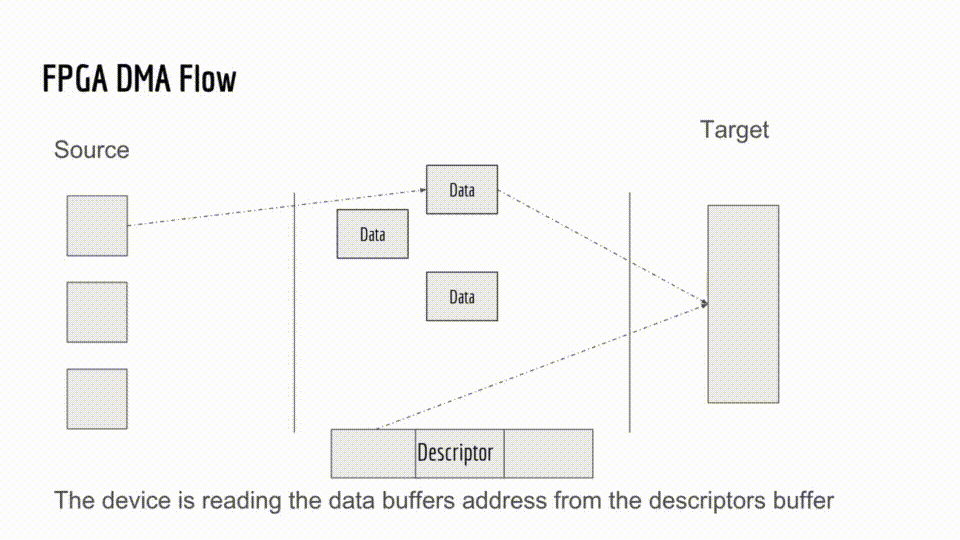
Step 6: Completion and Interrupt Handling
When the last descriptor finishes transferring data:
- An interrupt is raised, notifying the CPU of completion.
Polling vs. Interrupt-Driven DMA
- Polling: CPU constantly checks if DMA is done (inefficient).
- Interrupt-Driven DMA: FPGA notifies CPU via an interrupt (preferred).

💡 In may cases Interrupt-driven DMA is more efficient as it reduces CPU workload.
Step 7: Cleanup (DMA Close Routine)
After completion, buffers are unlocked, and memory is freed to prepare for the next transfer.
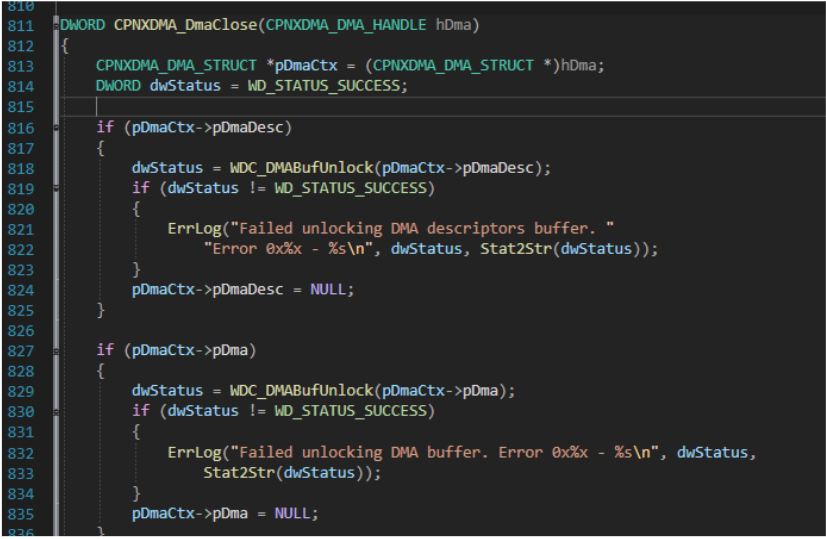
💡 Note: CPNX FPGAs don’t have a built-in stop function, so the cleanup routine is essential.
Performance Boost: Using the Kernel Plugin
The kernel plugin significantly improves DMA performance by reducing CPU context switching.
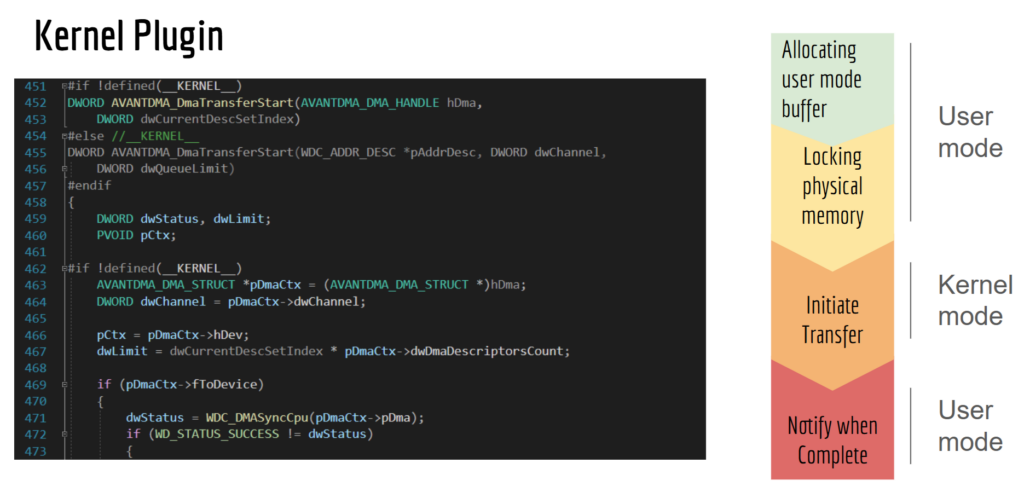
Performance Test Results:
- Kernel plugin improves DMA speed by 100%+ in some cases.
- Lower CPU overhead and faster transfer rates.
- Works automatically—no additional code is required.
CertusPro-NX (CPNX)
Avant™-E
- Easy user-mode driver development.
- Friendly DriverWizard allows hardware diagnostics without writing a single line of code.
- Automatically generates the driver code for the project in C, C#.NET, Visual Basic.NET, Python, Java, Delphi (Pascal) (Legacy), or Visual Basic 6.0 (Legacy).
- Supports any USB/PCI/PCI Express device, regardless of manufacturer.
- Enhanced support for specific chipsets frees the developer of the need to study the hardware’s specification.
- Allows accessing your device using a compiled application (in languages such as C/C++, C#.NET, Java, Visual Basic.NET) or from a running script (in scripting languages such as Python, PowerShell and MatLab).
- Applications are binary compatible across Windows 11/10/8.1/Server 2022/Server 2019/Server 2016 (Legacy WinDriver versions for server 2012, Windows 7 and XP, Windows 10 IoT Core for x86/x86_64/ARM CPUs on request).
- Applications are source code compatible across all supported operating systems – Windows 11/10/8.1/Server 2022/Server 2019/Server 2016/Server 2012(Legacy version for Windows 7 and XP), Embedded Windows 11/10/8.1, Windows CE (a.k.a. Windows Embedded Compact) 4.x–7.x (including Windows Mobile), macOS (Yosemite, El Capitan, Sierra, High Sierra, Mojave, Catalina, Big Sur, Monterey) and Linux (Kernel 2.6 and higher).
- Can be used with common development environments, including MS Visual Studio, CMake, XCode, Borland C++ Builder, Borland Delphi, Visual Basic 6.0, MS eMbedded Visual C++, MS Platform Builder C++, GCC, Windows GCC, or any other appropriate compiler/environment.
- No WDK, ETK, DDI or any system-level programming knowledge required.
- Supports multiple CPUs.
- Includes a dynamic driver loader.
- Comprehensive documentation and help files.
- Detailed examples in C, C#, Python, Java, PowerShell, VB.NET.
- HLK / HCK / WHQL certifiable driver (Windows).
- Signable driver (Linux Secure Boot, Apple Certification program).
- No run-time fees or royalties.
- Easy user-mode driver development.
- WinDriver products are accompanied with highly detailed technical references that are designed to assist you in various stages of the development process. If you have just started evaluating or using WinDriver, you may find our Quick Start Guides helpful. Should you require more in-depth information, or would like to know more about the technical aspects of WinDriver, please refer to our Online Manual. For other technical resources, such as FAQs and technical documents see WinDriver’s Support Page.
- Fast: Shorten driver development cycle and time to market.
- Simple: No OS internals or kernel knowledge required.
- Stable: Field-tested on thousands of HW and OS configurations.
- Enhanced Chipset Support: Silicon partners libraries to jump-start your driver development. Special samples for various PCI/USB chip vendors, such as Altera and Xilinx. WinDriver generates a skeletal driver code, customized for the user’s hardware.
- Multiple OS support and cross platform: WinDriver product line supports Windows 11/10/8.1/Server 2022/Server 2019/Server 2016/server 2012(Legacy version for Windows 7 and XP), Embedded Windows 11/10/8.1, Windows CE/Mobile, macOS and Linux. The same driver will run under all supported operating systems without any code modifications. Just recompile! If it’s a script – you don’t even need to recompile!
- Immediate Hardware Access and Debugging: Test your hardware through a graphical user-mode application, without having to write a single line of code. Monitor kernel level activity throughout the driver development process.
- Performance Optimization: Use WinDriver’s Kernel Plug-in technology to develop your driver in the user-mode, then run performance critical sections of it in the Kernel Mode (Ring 0) to achieve optimal performance.
- HLK / HCK/ WHQL Certifiable Driver: WinDriver’s Windows drivers are WHQL ready – you will not need to invest time and efforts on making your driver WHQL compliant. Jungo also can prepare the WHQL submission package for you.
- Field-proven quality: WinDriver’s technology enables you to concentrate on your core business and successfully create first-rate drivers without having to invest redundant resources in driver development from scratch.
- User-mode programming: WinDriver’s architecture enables driver development in the user mode, while maintaining kernel-mode performance.
- 64-bit Support: Allow utilizing the additional bandwidth provided by 64-bit hardware and enable 64-bit data transfer on x86 platforms running 32-bit operating systems. Drivers developed with WinDriver will attain significantly better performance results than drivers written with the DDK or other driver development tools that do not support this feature.
- Complete .NET Framework Support: Easily incorporate WinDriver’s C# or VB.NET code into your existing .NET application or PowerShell script using the powerful object oriented managed extensions for C++ library.
- Complete Java Support: Easily incorporate WinDriver’s API into your existing Java application using the powerful JNI binding of the complete WinDriver API.
- Complete Python Support: Easily incorporate WinDriver’s API into your existing Python script using the powerful Python binding of the complete WinDriver API.
WinDriver for Windows Desktop Supported Platforms
Windows 11 /Windows 10 / Windows 8/ Windows Server 2022 / Server 2019/ Server 2016 32 bit or 64 bit (x64: AMD64 and Intel EM64T) processor (Legacy Version Windows 7 & XP)
WinDriver for Linux Supported Platforms
- x86 32-bit, x86 64-bit (x86_64: AMD64).
- Supported Linux kernel (including embedded Linux):
- For x86 32-bit architectures: Linux kernel 2.6-5.18.2
- For x86 64-bit architectures: Linux kernel 2.6-5.18.2
- PCI / PCIe
- Any 32-bit or 64-bit development environment (depending on your target platform) supporting C/C++/C#/Visual Basic/Java/Python/PowerShell.
WinDriver for macOS Supported Platforms
- x86 64-bit (x86_64: AMD64).
- Supported macOS:
- MacOS 10.14, 10.15, 11.0 and MacOS 12.0 (ARM64 M1 version) are supported from version 14.8.0. (Legacy versions also support versions 10.10-10.13 as well).
- Any 64-bit development environment (depending on your target platform) supporting C/C++/C#/Visual Basic/Java/Python/PowerShell.
WinDriver for Linux Arm Supported Platforms
- WinDriver generally supports Linux ARM and ARM64 machines, but has been tested on the following systems and kernels:
- ARM Cortex A7 – Broadcom: Raspberry PI 2/3/4 : running Raspbian Stretch with kernel version 4.14.79-v7+. PI 4b: running Raspbian with kernel version 4.19.75-v7l+
- ARM Cortex A9 – Solid Run: I.MX6 MicroSoM i2 (Hummingboard2) running ARMbian’s Ubuntu Xenial Desktop Kernel Version 4.11.6-cubox
- ARM Cortex A9 – Boundary: BL-SL-I.MX6 (formerly Sabre LITE) running Debian nitrogen kernel version 4.9.88-6-boundary-14s
- ARM Cortex A15 – NVidia: Jetson TK1 running Ubuntu 16.04 kernel version 3.10.40-g8c4516e
- ARM64 Cortex A53 – Broadcom: Raspberry PI 3b+ â running 64bit Xubuntu 18.04 kernel version 4.15.0-1010-raspi2 or Ubuntu Server 18.04.2 kernel version 4.15.0-1033-raspi2
- ARM64 Cortex A57 – NVidia: Drive PX2 running Ubuntu 18.04 kernel version 4.9.38-rt25-tegra
- ARM64 Cortex A57 – NVidia: Jetson TX2 running Ubuntu 16.04 kernel version 4.4.38-tegra
- ARM64 v8.2 – NVidia: Jetson NX Xavier / Jetson AGX Xavier running Ubuntu 18.04 kernel version 4.9-tegra
- Any 32-bit or 64-bit development environment (depending on your target platform) supporting C/C++/C#/Visual Basic/Java/Python/PowerShell.
WinDriver(Legacy) for WinCE Supported Platforms
- An x86 / MIPS / ARM Windows CE 4.xâ7.0 (.NET) target platform
- WinCE 2013 – WEC 2013 8.0 for x86 and ARM
- For Windows CE 4.x – 6.0 – Microsoft Embedded Visual C++ with a corresponding target SDK, or Microsoft Platform Builder with a corresponding BSP (Board Support Package) for the target platform; also required for Windows Mobile 6.0 – Microsoft Visual Studio (MSDEV) .NET 2005
Download WinDriver Free 30 Days Trial
WinDriver
"*" indicates required fields
Software License Agreement of WinDriver (TM) Version v16.4.0
© Jungo Connectivity Ltd. 2024 All Rights Reserved
IMPORTANT – READ CAREFULLY: THIS SOFTWARE LICENSE AGREEMENT (“AGREEMENT”) IS A LEGAL AGREEMENT BETWEEN YOU AND JUNGO CONNECTIVITY LTD. (“JUNGO”), FOR THE WINDRIVER SOFTWARE PRODUCT ACCOMPANYING THIS LICENSE (THE “SOFTWARE”). BY INSTALLING, COPYING OR OTHERWISE USING THE SOFTWARE, YOU AGREE TO BE LEGALLY BOUND BY THE TERMS AND CONDITIONS OF THIS AGREEMENT. IF YOU DO NOT AGREE TO THE TERMS AND CONDITIONS OF THIS AGREEMENT, DO NOT INSTALL, COPY, OR OTHERWISE USE THE SOFTWARE.
- OWNERSHIP OF THE SOFTWARE. All right, title, and interest in and to the Software, including associated intellectual property rights, of any sort and/or kind, are and shall remain solely with Jungo and its licensors, and may be protected by copyright, trademark, patent and trade secret law and international treaties. This Agreement does not convey to you an interest in or to the Software, but only a limited, non-transferable, non-sublicensable, non-exclusive, and revocable right of use, in accordance with the terms of this Agreement. You may not remove any proprietary notices and/or any legends from the Software, in whole or in part.
- GRANT OF LICENSE. Jungo hereby grants you a personal, non-exclusive, nontransferable, non-sublicensable node-locked and time limited license to use the Software.
– Individuals: Jungo grants you, as an individual, a personal, non-exclusive, “single-user” license to use the Software on a single computer, in the manner provided below, at the site for which the license was given.
– Entities: If you are an entity, Jungo grants you the right to designate one individual within your organization (and only one) to have the right to use the Software on a single computer, in the manner provided below, at the site for which the license was given.
– License Scope: A single user license allows usage of WinDriver and redistribution of certain components (as defined below) within a single end product SKU, for a single device (identified by its VID/PID (USB) or VID/DID (PCI)), and without SDK/API capabilities. If you need extended license or distribution rights, please contact Jungo.
- EVALUATION LICENSE. If you have not yet paid license fees for the use of the Software, then Jungo hereby grants you a personal, non-exclusive, non-transferable and non-sublicensable license to internally use the Software for evaluation purposes only, for a period of 30 days (the “Evaluation License”). If, after the expiration of the Evaluation License, you wish to continue using the Software and accompanying written materials, you may do so by remitting the required payment to Jungo, and you will then receive a registration code and a license string that will permit you to use the Software on a single computer under one of the license schemes specified in Section 2 above.
- SERVICE OPTIMIZATION AND ENHANCEMENT. To continuously improve and optimize Jungo’s services, Jungo reserves the right to anonymously monitor, collect, and analyze usage data, including but not limited to API interactions, performance metrics, and system activity. Such data collection and analysis shall be conducted in compliance with all applicable laws and regulations and shall be used solely for the purpose of enhancing service performance, security, and reliability.
- SUBSCRIPTION, SERVICE CONTINUITY, RENEWAL, AND LATE PAYMENT PENALTIES. Access to the WinDriver and its associated features is provided on a subscription basis, subject to annual renewal. Failure to renew the subscription before the expiration date may result in the automatic termination of access to the platform and all related services, and additional fees (including but not limited to late payment penalties, administrative charges, or reinstatement costs). Upon termination, the user shall forfeit any rights to continued use, and we reserve the right to suspend or delete any associated accounts, data, or functionalities without further notice.
- OPEN SOURCE. The Software includes certain files that are subject to open source licenses. These files are identified in their header files (“Open Source Files”). You must use the Open Source Files in accordance with the terms of their respective licenses. In the event of any contradiction between the terms of this Agreement, and the terms of the open source license accompanying a certain Open Source File, the terms of the latter shall prevail, with regard to the said Open Source File.
RESTRICTIONS ON USE AND TRANSFER
- DISTRIBUTION OF FILES.
(a) You may not distribute, or otherwise transfer or assign, any portion of the Software, including any of the headers or source files that are included in the Software, unless otherwise expressly permitted in this Agreement, subject to the provisions of Section 4 above.
(b) Subject to your full and continued compliance with the terms of this Agreement, including the ongoing payment of annual license fees, you may distribute the following files:
Windows:
-windrvr1640.sys
-windrvr1640_legacy.sys
-windrvr1640.inf
-windrvr1640.cat
-wdapi1640.dll
-wdapi1640_32.dll
-wdapi1640_arm64.dll
-wdapi_dotnet1640.dll
-wdapi_dotnet1640_32.dll
-wdapi_netcore1640.dll
-wdapi_java1640.dll
-wdapi_java1640.jar
-wdreg.exe
-difxapi.dll
-devcon.exe
-windrvr1630.sys
-windrvr1630.inf
-wd1630.cat
-wdapi1630.dll
-wdapi_dotnet1630.dll
-wdapi_java1630.dll wdapi_java1600.jar
-windrvr1220.dll
-wdapi1220.dll
Linux:
-windrvr_gcc_v3.o_shipped
-windrvr_gcc_v3_regparm.o_shipped
-kp_linux_gcc_v3.o
-kp_linux_gcc_v3_regparm.o
-libwdapi1640.so libwdapi1640_32.so
-libwdapi_java1640.so
-libwdapi_java1640_32.so
-wdapi_java1640.jar
-wdapi_netcore1640.dll
-kp_wdapi1640_gcc_v3.o_shipped
-kp_wdapi1640_gcc_v3_regparm.o_shipped
-linux_wrappers.c
-linux_wrappers.h
-wdusb_linux.c
-wdusb_interface.h
-wd_ver.h
-linux_common.h
-windrvr.h
-windrvr_usb.h
-wdsriov_interface.h
-wdsriov_linux.c
-wdreg
-configure makefile.in
-configure.wd makefile.wd.in
-makefile.wd.kbuild.in
-configure.usb
-makefile.usb.in
-makefile.usb.kbuild.in
-setup_inst_dir
-windrvr_gcc_v2.a windrvr_gcc_v3.a windrvr_gcc_v3_regparm.a
-kp_linux_gcc_v2.o kp_linux_gcc_v3.o kp_linux_gcc_v3_regparm.o
-libwdapi1630.so
-libwdapi_java1630.so wdapi_java1600.java
-kp_wdapi1630_gcc_v2.a kp_wdapi1600_gcc_v3.a kp_wdapi1600_gcc_v3_regparm.a
-linux_wrappers.c linux_wrappers.h wdusb_linux.c
-wdusb_interface.h wd_ver.h linux_common.h windrvr.h windrvr_usb.h
-configure.wd makefile.wd.in makefile.wd.kbuild.in
-configure.usb makefile.usb.in makefile.usb.kbuild.in
macOS:
-libwdapi1640.dyld
-libwdapi_java1640.jar
-libwdapi_java1640.dyld
-wdapi_netcore1640.dll
-WinDriver1640.kext
-WinDriver1640.dext
-wd_mac_install.sh
-wd_mac_uninstall.sh
(c) The files listed in Section 5.b above may be distributed only as part of a complete application that you distribute under your organization name, and only if they significantly contribute to the functionality of your application. For avoidance of doubt, each organization distributing these files as part of the organization products is required to have valid license(s) under the organization name/VID, irrespective of the party who actually performed the product development. Licenses granted to subcontractors do not grant distribution or other rights to the organizations for which they are developing.
(d) The distribution of the windrvr.h header file is permitted only on Linux.
(e) You may not modify the distributed files specified in Section 5.b of this Agreement.
(f) You may not distribute any header file that describes the WinDriver functions, or functions that call the WinDriver functions and have the same basic functionality as that of the WinDriver functions.
- The Software may not be used to develop a development product, an API, or any products, which will eventually be part of a development product or environment, without the written consent of Jungo and subject to additional fees and licensing terms.
- You may make printed copies of the written materials accompanying the Software, provided that only users bound by this license use them.
- You may not allow any third party to use the Software, grant access to the Software (or any portion thereof) to any third party, or otherwise make any commercial use of the Software, including without limitation, assign, distribute, sublicense, transfer, pledge, lease, rent, or share your rights in the Software or any of your rights under this Agreement, all whether or not for any consideration.
- You may not translate, reverse engineer, decompile, disassemble, reproduce, duplicate, copy, or otherwise disseminate all or any part of the Software, or extract source code from the object code of the Software.
- Jungo reserves the right to revise, update, change, modify, add to, supplement, or delete any and all terms of this License Agreement; provided, however, that changes to this License Agreement will not be applied retroactively. Such changes will be effective with or without prior notice to you. You can review the most current version of this License Agreement under the WinDriver download form page.
- You may not incorporate or link any open source software with any open source software part of the Software, or otherwise take any action which may cause the Software or any portion thereof to be subjected to the terms of the Free Software Foundation’s General Public License (GPL) or Lesser General Public License (LGPL), or of any other open source code license.
- DISCLAIMER OF WARRANTY. THIS SOFTWARE AND ITS ACCOMPANYING WRITTEN MATERIALS ARE PROVIDED BY JUNGO “AS IS” WITHOUT ANY WARRANTY. ANY EXPRESS OR IMPLIED WARRANTIES, INCLUDING, BUT NOT LIMITED TO, THE IMPLIED WARRANTIES OF MERCHANTABILITY, FITNESS FOR A PARTICULAR PURPOSE, AND NON-INFRINGEMENT, ARE HEREBY DISCLAIMED TO THE FULLEST EXTENT PERMITTED UNDER APPLICABLE LAW.
- NO LIABILITY. TO THE FULLEST EXTENT PERMITTED BY APPLICABLE LAW, IN NO EVENT SHALL JUNGO OR ITS LICENSORS BE LIABLE FOR ANY DIRECT, INDIRECT, INCIDENTAL, SPECIAL, EXEMPLARY, OR CONSEQUENTIAL DAMAGES (INCLUDING, BUT NOT LIMITED TO, PROCUREMENT OF SUBSTITUTE GOODS OR SERVICES; LOSS OF USE, DATA, SAVINGS, IP INFRINGEMENT OR PROFITS; OR BUSINESS INTERRUPTION) HOWEVER CAUSED AND ON ANY THEORY OF LIABILITY, WHETHER IN CONTRACT, STRICT LIABILITY, OR TORT (INCLUDING NEGLIGENCE OR OTHERWISE) ARISING IN ANY WAY OUT OF THE USE OF THIS SOFTWARE, EVEN IF ADVISED OF THE POSSIBILITY OF SUCH DAMAGE.
- Governing Law. This Agreement and use of the Software are governed by the laws of the State of Israel, regardless of its conflict of laws rules, and the competent courts of the State of Israel shall have sole and exclusive jurisdiction over any dispute under this Agreement or otherwise related to the Software.
- Confidentiality. The Software, including any additional information related thereto, contains confidential and proprietary information of Jungo. Accordingly, you agree that you will not, nor allow any third party to, disseminate, transfer, grant access to, or otherwise disclose to any third party the Software or any part thereof or any other confidential or proprietary information of Jungo provided in connection therewith. You will maintain all copies of the Software and all related documentation in confidence.
- Termination and Effects of Termination. Jungo may terminate this Agreement and the licenses granted to you hereunder at any time if you breach any of your obligations hereunder, by issuance of written notice to such effect, addressed to you at the address you provided in your registration form. Upon expiration or other termination of this Agreement, the Licenses granted to you hereunder shall immediately and automatically be canceled, and you will immediately remove all copies of the Software from your computer(s) and cease any use thereof.
- Contact Details. If you have any questions concerning this Agreement or wish to contact Jungo for any reason —
Web site: https://www.jungo.com
Email: sales@jungo.com
- US GOVERNMENT RESTRICTED RIGHTS. The Software and documentation are provided with RESTRICTED RIGHTS.
Use, duplication, or disclosure by the Government is subject to restrictions set forth in subparagraph (c)(1) of The Rights in Technical Data and Computer Software clause at DFARS 252.227-7013 or subparagraphs (c)(1)(ii) and (2) of Commercial Computer Software – Restricted Rights at 48 CFR 52.227-19, as applicable.
- Automatic Renewal. The subscription shall be automatically renewed, unless Licensee notifies Licensor 30 days or more prior to the expiration date of the subscription, of its intent not to renew the subscription.
